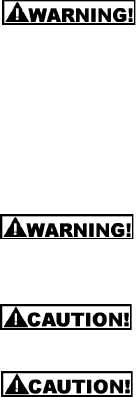
Page 8
BACKUP BATTERY REPLACEMENT
This alarm uses a 9 Volt Alkaline battery. The battery should last for at least one year under normal
operating conditions. The alarm has a low battery indicator, an audible "beep." It will operate at 30-
40 second intervals for a minimum of 7 days. When this indication occurs, replace the battery with
an Alkaline type (Eveready Energizer #522, Duracell #MN1604), or Lithium type (ULTRALIFE U9VL-
J), from your local retailer. Use the convenient QUICK DRAW
TM
pull-out battery drawer for easy
battery replacement.
Slide the QUICK DRAW
TM
pull-out battery drawer open and remove the battery. While observing
polarity, push the replacement battery into the battery drawer until it is held securely in place. Carefully
close the QUICK DRAW
TM
pull-out battery drawer.
Use only the batteries specified. Use of different batteries may have a detrimental effect on
the alarm. The constant exposures to high or low temperatures or high humidity may reduce
battery life.
When battery door is open, the battery will not power the alarm even if the battery is properly
installed.
Do not attempt to repair this combination alarm. Doing so will void your warranty.
REPAIRS AND SERVICES
The smoke alarm contains less than 1 microcurie (37 kilobecquerel) of Americium 241, a radioactive
material. The distribution of these ionization type smoke alarms is licensed by the U.S. Nuclear
Regulatory Commission; the consumer is exempt from any licensing or requirements. If the
smoke alarm is defective in any way, do not tamper with the unit. Return the unit for servicing. (See
warranty for instructions or in-warranty returns.) There will be a service charge for repairing out of
warranty units.
NATIONAL FIRE PROTECTION ASSOCIATION REQUIRED PROTECTION
For your information, the National Fire Protection Association's Standard 72, reads as follows:
“11.5.1 One- and Two-Family Dwelling Units. 11.5.1.1 Smoke Detection. Where required
by applicable laws, codes, or standards for the specified occupancy, approved single-
and multiple-station smoke alarms shall be installed as follows: (1) In all sleeping
rooms. Exception: Smoke alarms shall not be required in sleeping rooms in existing
one- and two-family dwelling units. (2) Outside of each separate sleeping area, in
immediate vicinity of the sleeping rooms. (3) On each level of the dwelling unit,
including basements. Exception: In existing one- and two-family dwelling units, approved
smoke alarms powered by batteries are permitted.
“A.11.8.3 Are More Smoke Detectors Desirable? The required number of smoke detectors
might not provide reliable early warning protection for those areas separated by a door
from the areas protected by the required smoke detectors. For this reason, it is
recommended that the householder consider the use of additional smoke detectors for
those areas for increased protection. The additional areas include the basement,
bedrooms, dining room, furnace room, utility room, and hallways not protected by the
required smoke detectors. The installation of smoke detectors in kitchens, attics
(finished or unfinished), or garages is not normally recommended, as these locations
occasionally experience conditions that can result in improper operation.”
The equipment should be installed using wiring methods in accordance with the National Fire
Protection Association’s Standard 72, Chapter 11. (National Fire Protection Association, Batterymarch
Park, Quincy, MA 02269).
THIS PRODUCT IS LISTED TO UL STANDARD FOR SAFETY,
UL217 6
TH
, BY UNDERWRITERS LABORATORIES











